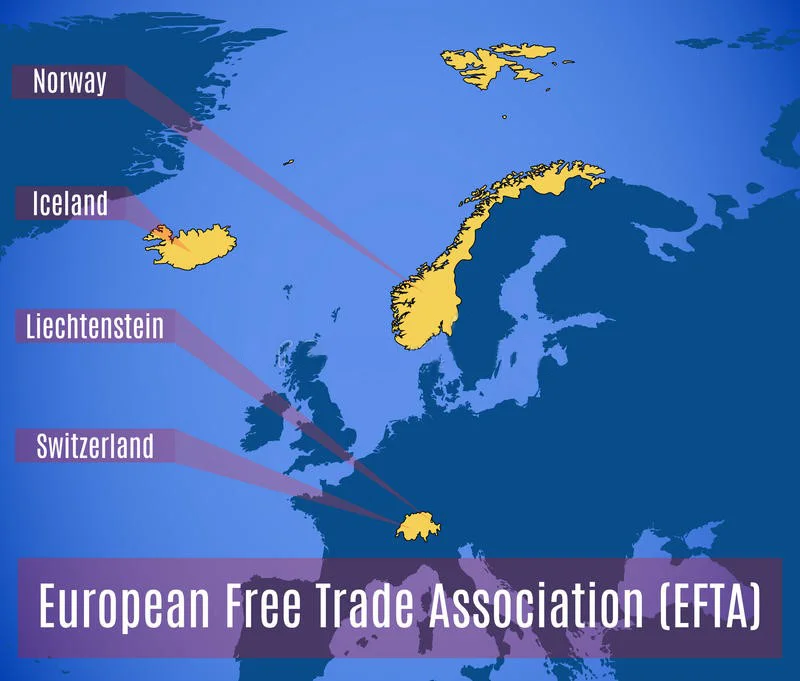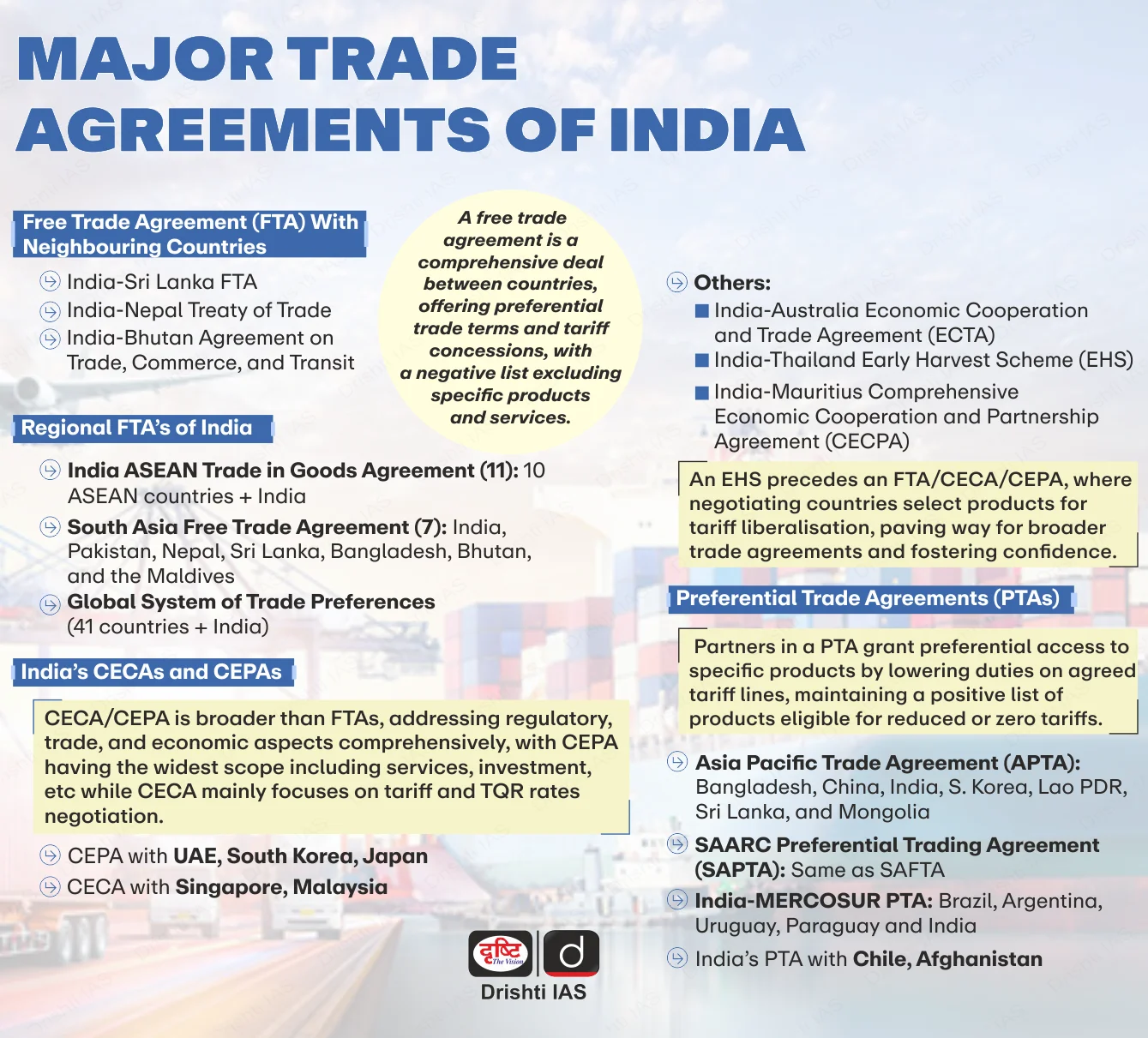International Relations
India-EFTA Trade and Economic Partnership Agreement
- 04 Aug 2025
- 7 min read
For Prelims: Trade and Economic Partnership Agreement, European Free Trade Association, Data exclusivity, Intellectual Property Rights, India-Norway Task Force on Blue Economy for Sustainable Development.
For Mains: Key Developments in India’s Economic Diplomacy, India and EFTA Relations.
Why in News?
The Union Minister of Commerce and Industry of India has announced that the Trade and Economic Partnership Agreement (TEPA) between India and the European Free Trade Association (EFTA) nations will come into force on 1st October 2025.
What are the Key Highlights of TEPA?
- About: The Trade and Economic Partnership Agreement (TEPA) between India and the EFTA (Iceland, Liechtenstein, Norway, Switzerland) was signed on 10th March 2024 after 21 rounds of negotiations since 2008.
- It aims to boost trade, attract investment, and create employment by reducing tariffs and non-tariff barriers.
- Objective: To ensure fair, transparent, and predictable market access for service providers and investors.
- It also enhances customs cooperation, trade procedures, IPR protection, and dispute resolution.
- Key Highlights of the Agreement:
- Strategic Investment Commitment: EFTA will invest USD 100 billion in India over 15 years, USD 50 billion in the first 10 years and another USD 50 billion in the next 5, to create 1 million jobs.
- Market Access & Tariff Concessions:
- EFTA offers 92.2% tariff lines, covering 99.6% of India’s exports (non-agricultural and processed agri-goods).
- India offers 82.7% tariff lines, covering 95.3% of EFTA exports, including gold (no change in effective duty).
- Indian rice (basmati and non-basmati) to get duty-free access without reciprocity.
- Safeguards & Exclusions: Sensitive sectors like dairy, soya, coal, and PLI-linked sectors are excluded. Sovereign wealth funds are exempted from FDI obligations.
- Services & Mobility: Supports Indian services in IT, education, culture, and sports. Enables Mutual Recognition Agreements (MRAs) in nursing, accountancy, and architecture.
- Legal Framework & IP Protection: Covers 14 chapters. India can withdraw tariff concessions if investment targets aren’t met. Generic drug production is protected; evergreening of patents addressed.
What is the European Free Trade Association (EFTA)?
- About: The European Free Trade Association (EFTA) is an intergovernmental organisation comprising Iceland, Liechtenstein, Norway, and Switzerland (all 4 are not a part of the European Union).
- It was established in 1960 under the Stockholm Convention to promote free trade and economic integration among member states and global partners.
- India-EFTA Trade Relations:
- Trading Partner: India is EFTA’s 5th-largest trading partner after the EU, US, UK, and China, with total two-way trade of USD 24.4 billion in 2024–25.
- Switzerland remains India's largest trading partner within EFTA, while trade with Iceland, Liechtenstein, and Norway remains relatively limited.
- Export & Imports: India exported goods worth USD 1.96 billion to EFTA nations and imported goods worth USD 22.45 billion, resulting in a significant trade deficit.
- Major imports from EFTA include gold (USD 20.7 billion in 2021–22), silver, coal, pharmaceuticals, vegetable oil, medical equipment, and dairy machinery.
- Key exports to EFTA comprise chemicals, iron and steel, gold, precious stones, yarns, sports goods, glassware, and bulk drugs.
- India-EFTA Desk: India and the EFTA launched the India-EFTA Desk to strengthen economic ties and facilitate investments under the TEPA.
- It is a dedicated investment facilitation mechanism established by Invest India to serve as a single-window platform for businesses from the EFTA nations to invest in India.
- Trading Partner: India is EFTA’s 5th-largest trading partner after the EU, US, UK, and China, with total two-way trade of USD 24.4 billion in 2024–25.
What are the Key Challenges Related to India- EFTA Relations?
- Persistent Trade Deficit: India has a large trade deficit with EFTA, mainly due to gold imports from Switzerland.
- Data Exclusivity & Public Health: EFTA’s demand for data exclusivity in pharma could hinder India’s generic drug production. India opposes it to protect public health and domestic industry.
- IPR Concerns under TEPA: TEPA’s IPR provisions may weaken India’s patent safeguards by affecting pre-grant opposition and local manufacturing requirements, raising concerns over transparency and access to affordable medicines.
Way Forward
- Mitigate Trade Deficit: Encourage value-added exports from India and diversify the trade basket to reduce dependency on gold imports and narrow the trade imbalance.
- Capacity Building & Sustainability: Use EFTA’s expertise in sustainability, clean technologies, and innovation to strengthen India's green transition and skilling ecosystem.
- Balanced IPR Framework: Ensure that Intellectual Property provisions safeguard innovation without undermining public health needs, especially India’s robust generic drug industry.
- Leverage India–EU FTA Momentum: Build on the ongoing India–EU FTA negotiations (targeted for 2025) to enhance regulatory alignment, address Non Tariff Barriers (NTBs), and foster resilient supply chains, strengthening India’s global trade positioning.
|
Drishti Mains Question : The India- EFTA (European Free Trade Association) Agreement stands as a potential game-changer for both parties, promising economic growth, job opportunities, and strengthening bilateral relations. Comment. |
UPSC Civil Services Examination, Previous Year Questions (PYQs)
Prelims:
Q1. Consider the following countries: (2018)
- Australia
- Canada
- China
- India
- Japan
- USA
Which of the above are among the ‘free-trade partners’ of ASEAN?
(a) 1, 2, 4 and 5
(b) 3, 4, 5 and 6
(c) 1, 3, 4 and 5
(d) 2, 3, 4 and 6
Ans: C
Q2. ‘Broad-based Trade and Investment Agreement (BTIA)’ is sometimes seen in the news in the context of negotiations held between India and (2017)
(a) European Union
(b) Gulf Cooperation Council
(c) Organization for Economic Cooperation and Development
(d) Shanghai Cooperation Organization
Ans: A








